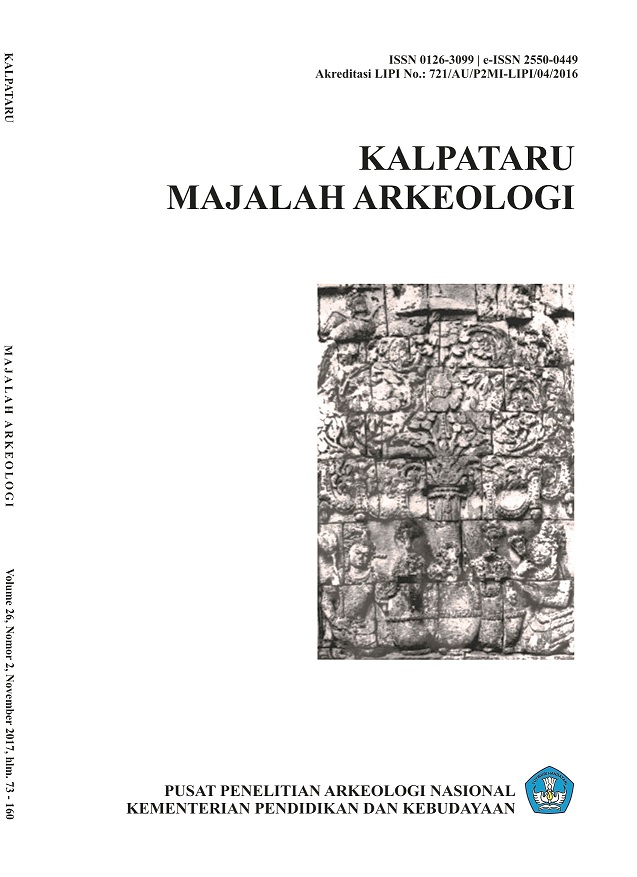PEMANFAATAN ANALISIS PHYTOLITH DAN STARCH DALAM STUDI ARKEOLOGI LINGKUNGAN
Main Article Content
Abstract
Environmental issues in archaeology have become a very interesting theme to be researches. Those theme relates to landscapes, environmental changes, site formation and human adaptation processes. Faunal ecofact and artifact are commonly used as research data nowdays. Analysis of plants residu are less common because of the scarcity of those remains in the archaeological sites,especially prehistory. This paper attempts to explain some possible uses of microscopic plant residua analysis in the form of phytolith and starch for environmental studies. The method used in this paper is literature study on microbotani as well as imitation experiments by combining several methods ever undertaken by previous researchers. This study shows that the plants remains , especially the microbotany form of phytolith and starch provide significant information about the types of plants in the pass, environmental changes and their utilization by humans.
Isu lingkungan dalam ilmu arkeologi menjadi tema yang sangat menarik untuk diungkap. Penelitian dengan tema tersebut berkaitan dengan bentang lahan, perubahan lingkungan, pembentukan situs, dan proses adaptasi manusia. Data yang digunakan selama inilebih banyak didominasi oleh data artefak dan ekofak berupa fauna. Analisis temuan flora berupa sisa tumbuhan belum banyak dilakukan mengingat sisa tumbuhan memang sedikit ditemukan dalam situs arkeologi, apalagi situs prasejarah. Tulisan ini bertujuan untuk memaparkan beberapa kemungkinan penggunaan analisis sisa tumbuhan yang bersifat mikroskopis berupa phytolith dan starch untuk studi lingkungan. Metode yang digunakan dalam tulisan ini adalah studi pustaka dari penelitian mikrobotani yang pernah dilakukan serta percobaan peniruan dengan memadukan beberapa metode yang pernah dilakukan oleh peneliti terdahulu. Hasil dari penelitian ini menunjukkan bahwa sisa tumbuhan, terutama yang bersifat mikroskopis berupa phytolith dan starch, memberikan informasi yang signifikan tentang jenis tumbuhan yang pernah ada, perubahan lingkungan, dan pemanfaatan oleh manusia.
Article Details
This work is licensed under CC BY-NC-SA 4.0
Authors whose articles are getting published must agree with the following rules:
- Publication rights for all contents published in Kalpataru Journal (printed and online versions) belong to The Board of Directors with acknowledgment of the authors (morale right still belongs to the author)
- Legal formal regulation for digital access to electronic journal follows the rule of Creative Commons license Commons Attribution-NonCommercial-ShareAlike (CC BY-NC-SA), which means Kalpataru Journal is a non-commercial publication, holds the right to keep, format, and manage the articles into the database, maintain, and publish articles
- Published articles both in printed and online versions are accessible for all purposes of education, research, and library archives. The board of directors is not responsible for any violations of the copyrights outside those purposes.
References
Alifah, 2017. Sumberdaya Tumbuhan dan Pemanfaatannya di Situs Gua Here Sorot Entapa dan Kuil Eu Lapa, Pulau Kisar Maluku: Berdasarkan Studi Arkeobotani. Tesis. Yogyakarta: Departement Arkeologi UGM
Anggraeni. 2012. “The Austronesian Migration Hypotesis a Seen from Prehistoric Settlements on the Karama River Mamuju, West Sulawesi. Disertasi Canbera: ANU.
Binford, Lewis, 1977. AnrBrothwell D.R. and A.M. Pollard, 2001. Handbook of Archaeological Sciences. England: John Wiley and Sons, LTD.
Bowdery, Doreen. 1999. Phytoliths from tropical sediments: reports from Southeast Asia dan Papua New Guinea. hlm. 159-168.
Brothwell and A.M. Pollard, 2001. Handbook of Archaeological Sciences. England: John Wiley & Sons Ltd. Denham, T. 2009.
Denham, Tim, 2009. "Archaeobotany in Australia and New Guinea, Practice, Potential and Prospect". Australian Archaeology, 1.
Dincauze,Dena F, 2000. Environmental Archaeology: Principles and Practice. New York: Cambridge University Press.
Edward, K.J. 2001. “Overview- Environmental Reconstruction” Handbook of Archaeological Sciences. England: John Wiley & Sons Ltd. Hal:103-110.
Idrus, I. H. 2015. "Kajian Lingkungan Purba Mikro Situs Gua Kidang, Desa Tinapan, Kecamatan Todanan, Kabupaten Blora (Analisis Fitolit)" Skripsi. Yogyakarta: Jurusan Arkeologi, Fakultas Ilmu Budaya UGM.
Kaars, V. D. 1989. "Aspect of Late Quarternary Palynology of Eastern Indonesia Deep Sea Cores". Neatherlands Journal of Sea Research vol 24. 4.
Kaars, Sander Van der, et.al. 2000. "A Late Quaternary Palaeocological Record from the Banda Sea, Indonesia: Patterns of Vegetation, Climate and Northern Australia". Palaeogeography, Palaeoclimatology, Palaecology vol 155, 135-153.
Lentfer, C. 2009. "Building a Comparantive Starch Reference Collection for Indonesia and its Application Palaeoenvironmental and Archaeological Research". Terra Australis vol 30. Hlm 80-101.
Loy, Thomas H. 1994."Method in the Analysis of Starch Residues on Prehistoric Stone Tool". Tropical Archaeobotany:Aplications and New Development. One world Archaeology 22. London: Routledge.Hlm : 86-116.
Lu, Houyuan and Kam-biu Liu. 2003. "Phytolith of Common Grasses in the Coastal Environments of Southeastern USA". Estuarine Coastal and Shelf Science vol 5. Hlm 587-600.
Piperno, Dolores, 2006. Phytoliths a Comprehensive Guide for Archaeology and Paleoecologists.
Piperno, Dolores. 2016. “Phytolith radiocarbon dating in archaeological and paleoecological research: A case study of phytoliths from modern Neotropical plants and a review of the previous dating evidence”. Journal of Archaeological Science Vol. 68. Hal 54-61.
Rahardjo, A.T. dan Yuwantiningsing,1985. “Analisis Pollen dalam Arekeologi”. Rapar Evaluasi Metode Penelitian Arkeologi II. Pandeglang: Puslit Arkenas.
Steward, J. 1939. Theory of Culture Cange. Urbana: Univercity of Illinois Press.
Vita, 1997. Identifikasi Tumbuhan berdasarkan Karakteristik Pollen: Suatu Dasar Identifikasi Pollen Sedimen dalam Arkeologi” Buletin Naditira Widya. No. 02/ 1997. Banjarmasin :Balai Arkeologi. Hal 112-120.
Wang, X. et.al.1999. "A Record of Fire, Vegetation and Climate Through the Last Three Glacial Cycles from Lombok Ridge Core G 4-6, Easten Indian Ocean, Indonesia". Palaeogeography, Palaeoclimatology, Plaeoconomy 147. Hlm 241-256.

